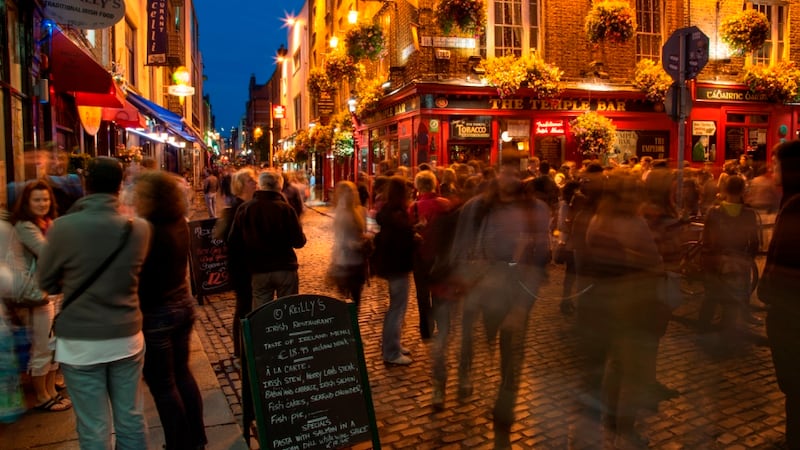This year, I will celebrate my 20th year as an adoptive Dubliner. In that time, apart from a brief fling I had with Paris, we have barely been apart. And inevitably, as with any long relationship, there are certain things I’ve had to do to keep the spark alive.
Not asking taxi drivers their views on immigration, for instance. Spending St Patrick’s Day somewhere else. And avoiding Temple Bar after 6pm.
But in the heat of my imminent move abroad, I appear to have got careless. I arranged to meet friends for dinner last weekend and, recklessly, we chose a restaurant in Temple Bar.

Crossing Dame Street to get there, we were still recognisably in Dublin. The buses thundering past; the smell of the warm tarmac mingling with the odour of Guinness and curry chips – it was all so reassuringly my adopted city that I had a nostalgic lump in my throat before I’d so much as packed a suitcase to leave.
But by the time we stepped on to Eustace Street, my pre-emptive homesickness had vanished – we might as well have been in Magaluf. Even early in the evening, with the temperature still in the low 20s, the atmosphere had all the charm of a nightclub urinal at 3am. Stag parties staggered around; day-trippers tripped past; those too out of it to do either slumped vacant-eyed in doorways.
In the restaurant where we ate an insipid, overpriced meal, staff told us that despite the stuffiness of the evening, they couldn’t open the tall glass windows surrounding the outdoor terrace because of the “undesirable elements” that would arrive and harass us.
Regeneration
When I moved to Dublin in 1993, the regeneration of Temple Bar was just beginning. Breathless reports about Ireland's soon-to-be sophisticated, bohemian cultural quarter filled the newspapers – I know, I wrote some of the articles. Back then, the harshest criticism anyone levelled at the area was that it might end up leading to a "ghettoisation of the arts", or that, as this newspaper put it, "the scale of the development plan [could] conflict jarringly with the still existing pattern of dilapidated backstreets [where] artists can be glimpsed hoisting damp canvasses up crumbling stairwells".
Today the stairwells are no longer crumbling, and the only thing being hoisted up them last Friday night was revellers too drunk to stay upright. On the street after our meal, the "unique character" of the place seemed to be best summed up by the placards advertising lapdancing clubs, the hen parties tottering precariously across the cobblestones, and the lakes of vomit. (Aimee Mann, on a visit to Dublin a few years ago, was equally impressed by this aspect of the authentic Temple Bar experience. She said: "I've never seen so many pools of vomit in my life.")
Dublin attraction
Yet despite all this, Temple Bar ranks 54th in the TripAdvisor list of the top 248 things to do in Dublin. Granted, this list also includes Busáras, so it's arguably not all that selective.
To be fair, Temple Bar is not without genuine attractions: the Gutter Bookshop is one of the best independent bookshops in the country; and it has the Ark, the Gallery of Photography, the Irish Film Institute, the markets and a handful of small boutiques.
But these all seem to be supporting the main act – and that’s the pubs. Temple Bar has a pub for every taste – as long as it’s big, loud, expensive and comes complete with diddly-eye playing on an endless loop and shillelaghs hanging from the ceiling. In the end, judging by the TripAdvisor reviews, it is these that are pulling in the punters, all eager to guzzle their taste of “authentic Irish craic” and then throw it all back up into the gutter.
It may not be too late for Ireland's once-promised cultural mecca. The Temple Bar Cultural Trust is being wound up, amid controversy over the construction of a €2.3 million rain-screen project for Meeting House Square. By the end of this year, its responsibilities will be transferred to the city council, and the area's cultural remit "reviewed and developed" to reflect the needs of all stakeholders.
With the right kind of planning, it may yet become something closer to what was originally envisaged: a bit more Left Bank; a bit less Magaluf-on-the-Liffey.
But I won’t be holding my breath – not unless it’s to ward off the stench of vomit.










